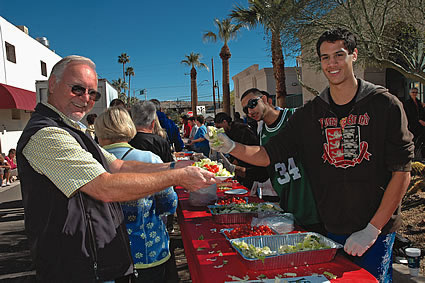Get a head . . . of lettuce
Become connected with the leafy green backbone of Yuma's economy

Yuma gets about 350 days of sunshine annually, which makes the region ideal for growing leafy vegetables. In fact, Kristan Sheppeard, the agritourism and special events manager for the Yuma Visitors Bureau, said that agriculture is one of two prominent industries in Yuma.
“Agriculture and military are huge here,” said Sheppeard. “It is important for us to celebrate our agricultural community to recognize and thank (the people behind it). Our goal is to highlight Yuma’s agricultural community as a whole.”
The salad days of spring
The agriculture industry in the Yuma region represents one-third of the annual economic output of the state, or roughly $3.2 billion. As leafy greens are one of the main staples of Yuma, the community dedicates a weekend to celebrating and honouring its agricultural heritage. The 13th annual Yuma Lettuce Days will take place from March 11 to 13. Sheppeard said this is the first year that Yuma Lettuce Days has partnered with the Southwest Ag Summit to connect the agricultural industry with the community.
Also for the first time, Yuma Lettuce Days will be a culinary festival with cooking demonstrations, contests and tastings from restaurants with local food. There will be agriculture displays and exhibits with cotton farmers selling clothes that are made from their crops and grain growers selling soap that is made from their wheat crops.
“There will be a salad contest,” said Sheppeard. “We also do a massive salad bar and we do farmer's markets. It’s about celebrating our agriculture and highlighting all of the things that are grown here. Although it is called Yuma Lettuce Days, we are also going to (showcase) our citrus community and our cotton.”
Sheppeard said that Lettuce Days will be held at two different venues—the Quartermaster Depot and Main Street. These venues will be connected by a tractor trail, which will have antique and current tractors on display. Acclaimed chefs will also be on site, offering visitors tasty samples of locally cooked food.
Locating the source
Part of Sheppeard’s job is marketing Yuma’s agricultural industry. In August 2010, the Food Network came to film in Yuma. What inspired the Food Network to film in Yuma, you ask? Well, isn’t it obvious—romaine, leaf and iceberg lettuce.
“It is amazing when you start talking to growers and they tell you that if you are sitting in Germany in the winter and eating lettuce, you are probably eating lettuce from Yuma,” said Sheppeard.






